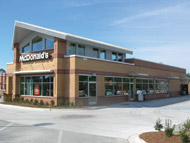|
FEATURE ARTICLE, MAY 2006
ABERCORN COMMON GOES FOR THE GREEN
In Savannah, Abercorn Common is built for commerce and a LEED certification.
Annette Boyle
 |
Located in Savannah, Georgia’s Abercorn Common, this McDonald’s is LEED certified.
|
|
Abercorn Common doesn’t turn green just for St. Patrick’s Day. The retail center at the intersection of Abercorn and White Bluff Road is the first retail development in the United States developed with LEED (Leadership in Energy and Environmental Design) core and shell standards. Developer Melaver Inc. expects full LEED-certification of the already LEED-registered project before the April 27 grand opening.
The U.S. Green Building Council created the LEED Green Building Rating System to establish the first national standard for developing green buildings. “People ask us what they can do to make their projects more green,” says Randy Peacock, project manager for Melaver. “I prefer to call them high-performance structures.” Environmentally friendly features of the Abercorn Common project that contribute to the “high-performance” measure include white roofs that reflect heat; extra insulation and reflective glass that can reduce energy costs by 15 to 40 percent; porous pavement in the parking lots to permit rain water to flow into the soil rather than the sewer system; and extensive landscaping and water features to create a cooler environment in the summer months.
The $30 million renovation of the 169,000-square-foot facility creates a high-end, up-market center, already 85 percent leased, on Savannah’s south side. “The renovation helps our tenants on both sides of the ledger,” says Martin Melaver, president of Melaver. “It reduces operating costs through energy efficiency and a number of tenants are reporting top sales nationwide at this location.”
In fact, the McDonald’s restaurant located in Abercorn Common is the first location to attain LEED certification for the fast food chain. The restaurant offers a number of sustainable features shared with the shopping center, such as bike racks for employees and customers, preferred parking for low emission hybrid vehicles, a reduction in water use, and windows that allow daylight to reach 75 percent of the restaurant’s interior. In addition, more than 50 percent of the wood used in constructing the restaurant came from sustainable managed forests and in excess of 20 percent of all the construction material is made from recycled content and manufactured locally. Melaver designed and constructed the restaurant as an outparcel of the development.
Some of the other tenants that will benefit from being located in Abercorn Common include Books A Million, Circuit City, F.P. Wortley Jewelers, Grand Harbour Imports, Home Goods, Loco’s Grill & Pub, Michael’s Arts & Crafts, Oreck Home Care, Panera Bread, Smoothie King, The RIITZ Salon, and Wild Birds Unlimited.
Abercorn Common represents Melaver, Inc.’s third project developed according to LEED standards, following the recent renovation of the company’s own headquarters and the historic rehabilitation of an 1890s office/retail space in downtown Savannah. Projects on the boards for 2006 include one of the first high-rise LEED-certified buildings in the country, a mixed-use residential and commercial facility on Peachtree Street in Atlanta; and Birmingham’s first LEED project, a mixed-use building in downtown.
In recognition of the company’s significant commitment to environmental stewardship, Melaver, Inc. received the Argon Award for Success in Sustainability on March 22 from Southface, an Atlanta environmental nonprofit. Southface Executive Director Dennis Creech said the selection committee wanted to recognize that “Melaver is a truly visionary firm. These are real estate professionals looking beyond changing the way properties are developed and constructed to how spaces are leased and managed—all with an eye toward sustainability.”
When the Melaver family entered the real estate development business in the 1990s, they wanted “to do it in a socially responsible manner,” Melaver says. “We concluded that everything we developed, whatever we acquired and renovated needed to be done sustainably.”
©2006 France Publications, Inc. Duplication
or reproduction of this article not permitted without authorization
from France Publications, Inc. For information on reprints
of this article contact Barbara
Sherer at (630) 554-6054.
|
